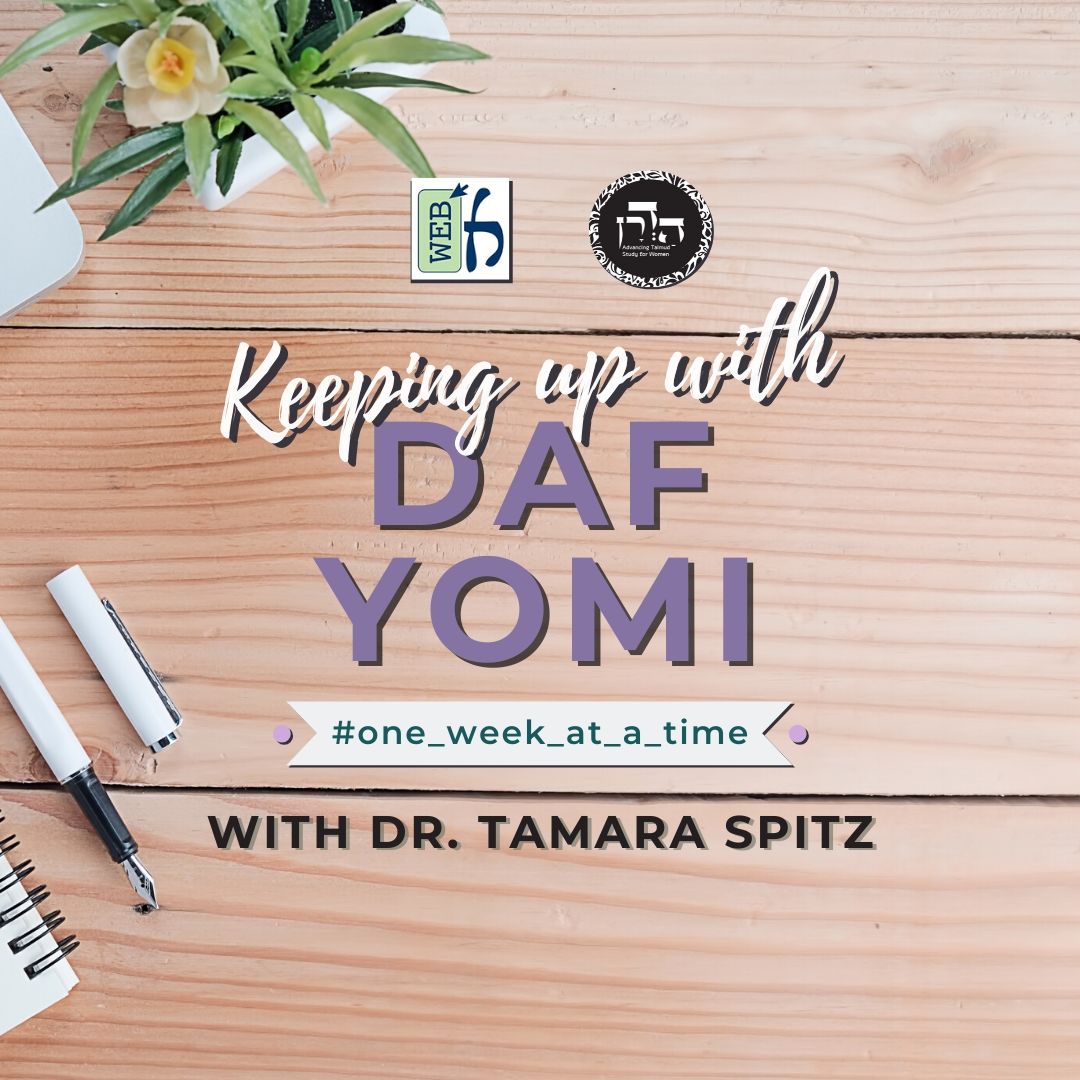Study Guide Menachot 77. What were the amounts used in the breads that were brought with the thanksgiving offering? How much flour? How many loaves? How were these laws derived?
This week’s learning is sponsored by Robert and Paula Cohen in loving memory of Joseph Cohen, Yosef ben Moshe HaCohen, z”l. “He was hard working, loved to sing, esp. as a chazan, and was very dedicated to his family and community.”
Want to dedicate learning? Get started here:

Today’s daily daf tools:
This week’s learning is sponsored by Robert and Paula Cohen in loving memory of Joseph Cohen, Yosef ben Moshe HaCohen, z”l. “He was hard working, loved to sing, esp. as a chazan, and was very dedicated to his family and community.”
Today’s daily daf tools:
Delve Deeper
Broaden your understanding of the topics on this daf with classes and podcasts from top women Talmud scholars.
New to Talmud?
Check out our resources designed to help you navigate a page of Talmud – and study at the pace, level and style that fits you.
The Hadran Women’s Tapestry
Meet the diverse women learning Gemara at Hadran and hear their stories.
Menachot 77
עֲשָׂרָה לְחָמֵץ – עִשָּׂרוֹן לְחַלָּה, וַעֲשָׂרָה לְמַצָּה – וּבְמַצָּה שָׁלֹשׁ מִינִין: חַלּוֹת, רְקִיקִין, וּרְבוּכָה. נִמְצְאוּ שְׁלֹשָׁה עֶשְׂרוֹנִים וּשְׁלִישׁ לְכׇל מִין וּמִין, וְשָׁלֹשׁ חַלּוֹת לְעִשָּׂרוֹן.
The mishna elaborates: There are ten tenths for the loaves of leavened bread, a tenth of an ephah per loaf. And there are ten tenths for the loaves of matza. And among the loaves of matza there are three types: Loaves, wafers, and those poached in water, ten loaves of each type. Consequently, there are three-and-one-third tenths of an ephah for each and every type, three loaves per tenth of an ephah.
וּבְמִדָּה יְרוּשַׁלְמִית הָיוּ שְׁלֹשִׁים קַב, חֲמִשָּׁה עָשָׂר לְחָמֵץ וַחֲמִשָּׁה עָשָׂר לְמַצָּה. חֲמִשָּׁה עָשָׂר לְחָמֵץ – קַב וּמֶחֱצָה לְחַלָּה, חֲמִשָּׁה עָשָׂר לְמַצָּה. וּבְמַצָּה שָׁלֹשׁ מִינִין: חַלּוֹת, וּרְקִיקִין, וּרְבוּכָה. נִמְצְאוּ חֲמֵשֶׁת קַבִּין לְכׇל מִין וּמִין, וּשְׁתֵּי חַלּוֹת לְקַב.
And in the Jerusalem measure there were thirty kav, fifteen kav for the loaves of leavened bread and fifteen for the loaves of matza. The mishna elaborates: There are fifteen kav for the loaves of leavened bread, one and one-half kav per loaf. And there are fifteen kav for the loaves of matza. And among the loaves of matza there are three types: Loaves, wafers, and those poached in water. Consequently, there are five kav for each and every type, two loaves per kav.
גְּמָ׳ הַתּוֹדָה הָיְתָה בָּאָה חָמֵשׁ סְאִין יְרוּשַׁלְמִיּוֹת. מְנָא הָנֵי מִילֵּי? אָמַר רַב חִסְדָּא: דְּאָמַר קְרָא ״הָאֵיפָה וְהַבַּת תֹּכֶן אֶחָד יִהְיֶה (לָכֶם)״. מָה בַּת שָׁלֹשׁ סְאִין, אַף אֵיפָה שָׁלֹשׁ סְאִין.
GEMARA: The mishna teaches: The flour for the loaves accompanying the thanks offering would come from a measure of five Jerusalem se’a, which are equivalent to six wilderness se’a. The se’a referred to in the Bible when the Jewish people were in the wilderness is smaller than the se’a used later in Jerusalem. This is equivalent to two ephahs, each ephah being three wilderness se’a. The Gemara asks: From where are these matters, i.e., that there are three se’a in an ephah, derived? Rav Ḥisda said: They are derived from a verse, as the verse states: “The ephah and the bat shall be of one measure” (Ezekiel 45:11). Therefore, just as the bat, a measure for liquids, is three se’a, so too the ephah, a measure for dry goods, is three se’a.
וּבַת גּוּפַהּ מְנָלַן? אִילֵּימָא מִדִּכְתִיב ״לָשֵׂאת (אֶת) מַעְשַׂר הַחֹמֶר הַבָּת״, אֵיפָה נָמֵי הָכְתִיב ״וַעֲשִׂירִית הַחֹמֶר הָאֵיפָה״! אֶלָּא חוֹמֶר לָא יָדַעְנָא כַּמָּה, הָכָא נָמֵי לָא יָדַעְנָא כַּמָּה.
The Gemara asks: And as for the bat itself, from where do we derive its measure? If we say that we derive it from that which is written in the same verse: “That the bat may contain the tenth-part of a ḥomer,” and since one ḥomer consists of thirty se’a, one bat is equivalent to three se’a, there is a difficulty: With regard to an ephah as well, isn’t it written in the same verse: “And the ephah the tenth-part of a ḥomer”? Why, then, must the measure of an ephah be derived from that of a bat? Rather, I do not know how much the measure of a ḥomer is; consequently, when the verse states that the ephah is one-tenth of one ḥomer, this does not demonstrate the measure of the ephah. Here too, I do not know how much the measure of the bat is.
אֶלָּא מֵהָכָא: ״וְחֹק הַשֶּׁמֶן הַבַּת הַשֶּׁמֶן וּמַעְשַׂר הַבַּת מִן הַכּוֹר עֲשֶׂרֶת הַבַּתִּים חוֹמֶר כִּי עֲשֶׂרֶת הַבַּתִּים חוֹמֶר״.
Rather, derive the volume of the ephah from here, from a subsequent verse, where it is written with regard to separating teruma: “And the set portion of oil, the bat of oil, shall be the tithe of the bat out of the kor, which is ten bat, even a ḥomer; for ten bat are a ḥomer” (Ezekiel 45:14). The verse states that there are ten bat in one kor and ten bat in one ḥomer. Since it is known that one kor is equivalent to thirty se’a, the verse indicates that there are also thirty se’a in one ḥomer. It can therefore be derived from the verse that there are three se’a in one bat, and consequently, three se’a in one ephah.
אָמַר שְׁמוּאֵל: אֵין מוֹסִיפִין עַל הַמִּדּוֹת יוֹתֵר מִשְּׁתוּת, וְלֹא עַל הַמַּטְבֵּעַ יוֹתֵר מִשְּׁתוּת, וְהַמִּשְׂתַּכֵּר לֹא יִשְׁתַּכֵּר יוֹתֵר מִשְּׁתוּת.
§ The mishna teaches that the Sages increased the size of the measures so that five Jerusalem measures are equal to six wilderness measures. With regard to the practice of augmenting measures, Shmuel says: If the residents of a certain place want to change the standard of their measures and augment them by a certain fraction, they may not increase the measures by more than one-sixth, and they may not increase the value of a coin by more than one-sixth of its previous value. And one who profits from his sales may not profit by more than one-sixth.
מַאי טַעְמָא? אִילֵּימָא מִשּׁוּם אַפְקוֹעֵי תַּרְעָא – אִי הָכִי, שְׁתוּת נָמֵי לָא!
The Gemara analyzes these statements. When Shmuel said: They may not increase the measures by more than one-sixth, what is the reason for this? If we say it is because doing so causes market prices to rise, the same concern should apply to raising the prices by one-sixth, and therefore that should also not be allowed.
אֶלָּא מִשּׁוּם אוֹנָאָה, כִּי הֵיכִי דְּלָא לֶיהֱוֵי בִּיטּוּל מִקָּח, וְהָא אָמַר רָבָא: כׇּל דָּבָר שֶׁבְּמִדָּה וְשֶׁבְּמִשְׁקָל וְשֶׁבְּמִנְיָן, אֲפִילּוּ פָּחוֹת מִכְּדֵי אוֹנָאָה – חוֹזֵר!
Rather, one might say that the prohibition is due to concern for exploitation; and they may increase the measures only by up to one-sixth so that there will not be nullification of the transaction, as the transaction is nullified only when the disparity is more than one-sixth of the value of the item. The Gemara raises an objection: But doesn’t Rava say: With regard to any item that is otherwise subject to the halakhot of exploitation, and it is sold by measure, or by weight, or by number, even if the disparity was less than the measure of exploitation in the transaction, the transaction is reversed? A disparity of one-sixth between the value of an item and its price constitutes exploitation only in cases where there is room for error in assessing the value of an item. In a case where the details of the item are easily quantifiable, any deviation from the designated quantity results in a nullification of the transaction. The statement of Shmuel concerns sales involving measures.
אֶלָּא מִשּׁוּם תַּגָּרָא, כִּי הֵיכִי דְּלָא לִמְטְיֵיהּ דְּיָאנָה. דְּיָאנָה הוּא דְּלָא לִימְטְיֵיהּ, רְוָחָא לָא בָּעֵי? זְבֵן וְזַבֵּין – תַּגָּרָא אִיקְּרִי?!
Rather, the prohibition is for the benefit of the merchant, so that there will not be a loss suffered by a merchant who might not realize that a new standard was issued, and might sell in accordance with the old standard. Since a merchant usually enjoys a profit of one-sixth of the value of an item, if the standard is not increased by more than this amount he will not suffer a loss, as at worst he will forfeit his profit margin. The Gemara notes: This explanation is also difficult, since even if the aim is to ensure that there will not be a loss for the merchant, does he not need to earn a profit? There is a well-known adage in this regard: If you buy and sell without earning any profit, will you be called a merchant? A merchant must profit from his sales; therefore, if this decree was instituted for the protection of merchants, the Sages should have ensured that they earn a profit.
אֶלָּא אָמַר רַב חִסְדָּא: שְׁמוּאֵל קְרָא אַשְׁכַּח וּדְרַשׁ, ״הַשֶּׁקֶל עֶשְׂרִים גֵּרָה עֶשְׂרִים שְׁקָלִים חֲמִשָּׁה וְעֶשְׂרִים שְׁקָלִים עֲשָׂרָה וַחֲמִשָּׁה שֶׁקֶל הַמָּנֶה יִהְיֶה לָכֶם״, מָנֶה מָאתָן וְאַרְבְּעִין הָווּ.
Rather, Rav Ḥisda said: The prohibition is not based on logical reasoning. Instead, Shmuel found a verse and interpreted it homiletically: “And the shekel shall be twenty gera; twenty shekels, five and twenty shekels, ten, and five shekels, shall be your maneh” (Ezekiel 45:12). According to this verse, the sum of all of these numbers, sixty shekels, is equivalent to a maneh. This is problematic: How can a maneh consist of sixty shekels? Since each biblical shekel is equivalent to four dinars, if a maneh is equal to sixty shekels, a maneh is two hundred and forty dinars. But a maneh is actually equal to twenty-five shekels, which are one hundred dinars.
אֶלָּא שְׁמַע מִינַּהּ תְּלָת: שְׁמַע מִינַּהּ מָנֶה שֶׁל קוֹדֶשׁ כָּפוּל הָיָה, וּשְׁמַע מִינַּהּ מוֹסִיפִין עַל הַמִּדּוֹת וְאֵין מוֹסִיפִין יוֹתֵר מִשְּׁתוּת, וּשְׁמַע מִינַּהּ שְׁתוּתָא מִלְּבַר.
Rather, one can learn from the verse three matters: Learn from it that the sacred maneh was doubled, so that it equaled two hundred, not one hundred, dinars. And furthermore, as Ezekiel stated that the maneh will be sixty shekels, not fifty, learn from it that a community may increase measures, but they may not increase them by more than one-sixth. And learn from it that the one-sixth is calculated from the outside, i.e., it is one-sixth of the final sum, which is one-fifth of the previous sum.
אָמַר רָבִינָא: מַתְנִיתִין נָמֵי דַּיְקָא, דְּקָתָנֵי: תּוֹדָה הָיְתָה בָּאָה חָמֵשׁ סְאִין יְרוּשַׁלְמִיּוֹת שֶׁהֵן שֵׁשׁ מִדְבָּרִיּוֹת, שְׁמַע מִינַּהּ.
Ravina said: The mishna is also precisely formulated so as to reflect the fact that the one-sixth increase is calculated from the outside, as it teaches: The flour for the loaves accompanying the thanks offering would come from a measure of five Jerusalem se’a of flour, which are equivalent to six wilderness se’a. One can infer that the se’a could be increased by only one-sixth from the outside. The Gemara affirms: Indeed, conclude from it that this is the halakha.
מַתְנִי׳ מִכּוּלָּם הָיָה נוֹטֵל אֶחָד מֵעֲשָׂרָה תְּרוּמָה, שֶׁנֶּאֱמַר: ״וְהִקְרִיב מִמֶּנּוּ אֶחָד מִכׇּל קׇרְבָּן תְּרוּמָה לַה׳״, ״אֶחָד״ – שֶׁלֹּא יִטּוֹל פָּרוּס, ״מִכׇּל קׇרְבָּן״ – שֶׁיְּהוּ כׇּל הַקָּרְבָּנוֹת שָׁוִין, שֶׁלֹּא יִטּוֹל מִקׇּרְבָּן עַל חֲבֵירוֹ. ״לַכֹּהֵן הַזֹּרֵק אֶת דַּם הַשְּׁלָמִים לוֹ יִהְיֶה״, וְהַשְּׁאָר נֶאֱכָל לַבְּעָלִים.
MISHNA: From all of the four types of loaves accompanying the thanks offering, one takes one loaf from each set of ten as teruma, to be given to a priest, as it is stated: “And he shall present from it one of each offering as a teruma unto the Lord; to the priest that sprinkles the blood of the peace offerings against the altar it shall be given” (Leviticus 7:14). The verse is analyzed: “One” indicates that one should not take a sliced loaf; “of each offering” indicates that all the offerings should be equal, i.e., that one should not take a loaf from one type of offering for another type; “to the priest that sprinkles the blood of the peace offerings against the altar it shall be given,” and the rest of the loaves are eaten by the owner.
גְּמָ׳ תָּנוּ רַבָּנַן: ״וְהִקְרִיב מִמֶּנּוּ״ – מִן הַמְחוּבָּר, ״אֶחָד״ – שֶׁלֹּא יִטּוֹל פָּרוּס, ״מִכׇּל קׇרְבָּן״ – שֶׁיְּהוּ כׇּל הַקָּרְבָּנוֹת (שָׁווֹת) [שָׁוִוין], שֶׁלֹּא יִטּוֹל מִן הַקׇּרְבָּן עַל חֲבֵירוֹ, ״תְּרוּמָה לַה׳״ – אֵינִי יוֹדֵעַ מִכַּמָּה הִיא,
GEMARA: The mishna teaches some of the halakhot of teruma to be taken from the loaves of the thanks offering that are derived from the verse: “And he shall present from it one of each offering as a teruma unto the Lord.” The Gemara cites a baraita that interprets the same verse: The Sages taught in a baraita: The phrase “And he shall present from it” indicates that the loaves must all be as one, i.e., teruma may be taken from the loaves only when they are joined together in one place. “One” indicates that one should not take a sliced loaf. “Of each offering” indicates that all the offerings should be equal, i.e., that one should not take a loaf from one type of offering for another type. When the verse states: “As a teruma unto the Lord,” I do not know from how many loaves the teruma is taken.
הֲרֵינִי דָּן: נֶאֱמַר כָּאן ״תְּרוּמָה״, וְנֶאֱמַר בִּתְרוּמַת מַעֲשֵׂר ״תְּרוּמָה״, מָה לְהַלָּן אֶחָד מֵעֲשָׂרָה, אַף כָּאן אֶחָד מֵעֲשָׂרָה.
I therefore derive this from a verbal analogy: It is stated here, in the passage of the loaves describing the thanks offering: “Teruma,” and it is stated with regard to teruma of the tithe: “Then you shall set apart from it a teruma for the Lord, even a tithe of the tithe” (Numbers 18:26). Just as below, with regard to teruma of the tithe, one out of every ten is separated as teruma, so too here, with regard to the loaves of the thanks offering, one out of every ten loaves is separated as teruma.
אוֹ כְּלָךְ לְדֶרֶךְ זוֹ: נֶאֱמַר כָּאן ״תְּרוּמָה״, וְנֶאֱמַר בְּבִכּוּרִים ״תְּרוּמָה״, מָה לְהַלָּן אֵין לָהּ שִׁיעוּר, אַף כָּאן אֵין לָהּ שִׁיעוּר.
Or perhaps, go this way and derive the measure from a different verbal analogy: It is stated here: “Teruma,” and it is stated with regard to first fruits: “Teruma” (Deuteronomy 12:17). Just as below, with regard to first fruits, it has no measure, so too here, say that it has no measure.
נִרְאֶה לְמִי דּוֹמֶה: דָּנִין תְּרוּמָה שֶׁאֵין אַחֲרֶיהָ תְּרוּמָה, מִתְּרוּמָה שֶׁאֵין אַחֲרֶיהָ תְּרוּמָה, וְאַל יוֹכִיחַ בִּכּוּרִים, שֶׁיֵּשׁ אַחֲרֵיהֶן תְּרוּמָה.
The baraita continues: Let us consider to which of the two cases, teruma of the tithe or the first fruits, the case of teruma of the loaves of the thanks offering is more similar. It is logical that one derives the halakha of a teruma that is not followed by another teruma, such as teruma of the loaves of the thanks offering, from a teruma that is not followed by another teruma, such as teruma of the tithe. And the case of the first fruits will not serve as proof, since they are followed by another teruma, as teruma and tithes are taken after the first fruits are separated.
אוֹ כְּלָךְ לְדֶרֶךְ זוֹ: דָּנִין תְּרוּמָה הַנֶּאֱכֶלֶת בְּמָקוֹם קָדוֹשׁ, מִתְּרוּמָה הַנֶּאֱכֶלֶת בְּמָקוֹם קָדוֹשׁ, וְאַל תּוֹכִיחַ תְּרוּמַת מַעֲשֵׂר, שֶׁנֶּאֱכֶלֶת בְּכׇל מָקוֹם.
Or perhaps, go this way and reason that one derives the halakha of teruma of the loaves of the thanks offering, which is eaten in a sacred place, in Jerusalem, from teruma of the first fruits, which is eaten in a sacred place, in Jerusalem. And the case of teruma of the tithe will not serve as proof, as it may be eaten anywhere.
תַּלְמוּד לוֹמַר ״מִמֶּנּוּ תְּרוּמָה לַה׳״, וּכְתִיב בִּתְרוּמַת מַעֲשֵׂר ״מִמֶּנּוּ תְּרוּמָה״ – לִגְזֵירָה שָׁוָה.
Since both of these comparisons are equally plausible, the verse states with regard to the loaves of the thanks offering: “From it…a teruma unto the Lord,” and, similarly, it is written with regard to teruma of the tithe: “From it a teruma,” to indicate that there is a verbal analogy between the two, from which it can be derived that one separates one out of every ten loaves of the thanks offering as teruma.
לָמַדְנוּ לִתְרוּמָה שֶׁהִיא אֶחָד מֵעֲשָׂרָה, אֲבָל אֵינִי יוֹדֵעַ מִכַּמָּה הִיא חַלָּה. הֲרֵינִי דָּן: נֶאֱמַר כָּאן ״לֶחֶם״, וְנֶאֱמַר לְהַלָּן בִּשְׁתֵּי הַלֶּחֶם ״לֶחֶם״, מָה לְהַלָּן עִשָּׂרוֹן לְחַלָּה, אַף כָּאן עִשָּׂרוֹן לְחַלָּה.
The baraita continues: We have learned with regard to teruma of the loaves of the thanks offering that its measure is one out of every ten. But I do not know from this verbal analogy from how much flour each leavened loaf is to be prepared. I therefore derive this from a verbal analogy: It is stated here, in the passage concerning the loaves of the thanks offering: “Bread” (Leviticus 7:13), and it is stated there, with regard to the two loaves, i.e., the public offering on Shavuot of two loaves from the new wheat: “Bread” (Leviticus 23:17). Just as there, with regard to the two loaves, one prepares the loaves with a tenth of an ephah per loaf, so too here, with regard to the loaves of leavened bread of the thanks offering, one prepares the loaves with a tenth of an ephah per loaf.
אוֹ כְּלָךְ לְדֶרֶךְ זוֹ, נֶאֱמַר כָּאן ״לֶחֶם״, וְנֶאֱמַר בְּלֶחֶם הַפָּנִים ״לֶחֶם״, מָה לְהַלָּן שְׁנֵי עֶשְׂרוֹנוֹת, אַף כָּאן שְׁנֵי עֶשְׂרוֹנוֹת.
Or perhaps, go this way and derive the halakha from a different verbal analogy: It is stated here, with regard to the loaves of the thanks offering: “Bread,” and it is stated there, with regard to the shewbread: “Bread” (Leviticus 24:7). One can conclude that just as there, with regard to the shewbread, each of the twelve loaves is baked from two-tenths of an ephah flour, so too here, each of the loaves of leavened bread of the thanks offering should be baked from two-tenths of an ephah of flour.
נִרְאֶה לְמִי דּוֹמֶה? דָּנִין מִנְחָה הַבָּאָה חָמֵץ עִם הַזֶּבַח, מִמִּנְחָה הַבָּאָה חָמֵץ עִם הַזֶּבַח, וְאַל יוֹכִיחַ לֶחֶם הַפָּנִים, שֶׁאֵינוֹ בָּא חָמֵץ עִם הַזֶּבַח.
The baraita continues: Let us consider to which of the two cases, the two loaves or the shewbread, the case of the leavened loaves of the thanks offering is more similar. It is logical that one derives the halakha of the loaves of leavened bread of the thanks offering, which is a meal offering that comes as leavened bread along with an animal offering, from another meal offering that comes as leavened bread along with an animal offering, such as the two loaves, which are also leavened, and which come with animal offerings (see Leviticus 23:17–19). And the shewbread will not serve as proof, since it does not come as leavened bread, nor does it come with an animal offering.
אוֹ כְּלָךְ לְדֶרֶךְ זוֹ, דָּנִין מִנְחָה הַבָּאָה מֵאָרֶץ וְחוּצָה לָאָרֶץ, מִן הֶחָדָשׁ וּמִן הַיָּשָׁן, מִמִּנְחָה הַבָּאָה מֵאָרֶץ וְחוּצָה לָאָרֶץ, מִן הֶחָדָשׁ וּמִן הַיָּשָׁן, וְאַל יוֹכִיחוּ שְׁתֵּי הַלֶּחֶם, שֶׁאֵין בָּאוֹת אֶלָּא מִן הֶחָדָשׁ וּמִן הָאָרֶץ.
Or perhaps, go this way and reason that one derives the halakha of the loaves of leavened bread of the thanks offering, which is a meal offering that can come from the grain of Eretz Yisrael or of outside of Eretz Yisrael, from new grain or from old grain; from the halakha of the shewbread, which is also a meal offering that can come from the grain of Eretz Yisrael or from outside of Eretz Yisrael, from new grain or from old grain. And the two loaves will not serve as proof, since they can come only from new grain and from Eretz Yisrael.
תַּלְמוּד לוֹמַר ״מִמּוֹשְׁבֹתֵיכֶם תָּבִיאּוּ לֶחֶם תְּנוּפָה שְׁתַּיִם״, שֶׁאֵין תַּלְמוּד לוֹמַר ״תָּבִיאוּ״, וּמָה תַּלְמוּד לוֹמַר ״תָּבִיאוּ״? שֶׁכׇּל מַה שֶּׁאַתָּה מֵבִיא מִמָּקוֹם אַחֵר הֲרֵי הוּא כָּזֶה, מַה לְּהַלָּן עִשָּׂרוֹן לְחַלָּה אַף כָּאן עִשָּׂרוֹן לְחַלָּה.
Since both of these comparisons are equally plausible, the verse states concerning the two loaves: “You shall bring out of your dwellings two loaves of waving” (Leviticus 23:17). As there is no need for the verse to state: “You shall bring,” what, then, is the meaning when the verse states: “You shall bring”? This indicates that whatever, i.e., any meal offering, you bring from a different place, it must be like this, i.e., the two loaves. Therefore, just as there, in the case of the two loaves, the measure is a tenth of an ephah per loaf, so too here, in the case of the loaves of leavened bread of the thanks offering, the measure is a tenth of an ephah per loaf.
אִי מָה לְהַלָּן שְׁנֵי עֶשְׂרוֹנוֹת, אַף כָּאן שְׁנֵי עֶשְׂרוֹנוֹת? תַּלְמוּד לוֹמַר ״תִּהְיֶינָה״.
But if so, perhaps one can derive that just as there, in the case of the two loaves, the entire measure for the two loaves is two-tenths of an ephah, so too here, in the case of the loaves of leavened bread of the thanks offering, the entire measure for all ten loaves of leavened bread is two-tenths. To exclude this possibility, the same verse states: “They shall be,” to indicate that each leavened loaf is prepared from a tenth of an ephah. Accordingly, the ten loaves of leavened bread of the thanks offering are prepared with a total of ten tenths of an ephah.
לָמַדְנוּ עֲשָׂרָה לְחָמֵץ, עֲשָׂרָה לְמַצָּה מִנַּיִן? תַּלְמוּד לוֹמַר ״עַל חַלֹּת לֶחֶם חָמֵץ״.
The baraita continues: We have learned that there are ten tenths of an ephah of flour for the loaves of leavened bread accompanying the thanks offering. From where is it derived that there are ten tenths of an ephah for the thirty loaves of matza? The verse states: “If he brings it for a thanks offering, then he shall bring with the thanks offering unleavened cakes mingled with oil, and unleavened wafers spread with oil, and cakes mingled with oil, of fine flour poached. With cakes of leavened bread he shall present his offering, with the sacrifice of his peace offerings for thanks” (Leviticus 7:12–13).
נֶגֶד חָמֵץ, הָבֵא מַצָּה. נִמְצְאוּ עֶשְׂרִים עֶשְׂרוֹנוֹת לַחְמֵי תוֹדָה, עֲשָׂרָה לְחָמֵץ, וַעֲשָׂרָה לְמַצָּה.
By mentioning all the loaves of unleavened bread in one verse and the loaves of leavened bread in the subsequent verse, it is indicated that one must bring the matza in a measure corresponding to the measure of the loaves of leavened bread. Consequently, there are twenty tenths of flour for the loaves of the thanks offering, ten for the loaves of leavened bread, and ten for the matza.
יָכוֹל עֲשָׂרָה שֶׁבְּמַצָּה לֹא יְהוּ כּוּלָּן אֶלָּא מִמִּין אֶחָד? תַּלְמוּד לוֹמַר ״אִם עַל תּוֹדָה יַקְרִיבֶנּוּ וְהִקְרִיב עַל זֶבַח הַתּוֹדָה חַלּוֹת מַצּוֹת בְּלוּלֹת בַּשֶּׁמֶן וּרְקִיקֵי מַצּוֹת מְשֻׁחִים בַּשָּׁמֶן סֹלֶת מֻרְבֶּכֶת וְגוֹ׳״. נִמְצְאוּ שְׁלֹשָׁה עֶשְׂרוֹנִים וּשְׁלִישׁ לְכׇל מִין וּמִין, וְשָׁלֹשׁ חַלּוֹת לְעִשָּׂרוֹן, וְנִמְצְאוּ לַחְמֵי תוֹדָה אַרְבָּעִים. נוֹטֵל מֵהֶן אַרְבַּע וְנוֹתֵן לְכֹהֵן, וְהַשְּׁאָר נֶאֱכָלִים לַבְּעָלִים.
One might have thought that one brings ten loaves of matza, and that all of them shall be of only one type. Therefore, the verse states: “If he brings it for a thanks offering, then he shall bring with the thanks offering unleavened cakes mingled with oil, and unleavened wafers spread with oil, and cakes mingled with oil, of fine flour poached. With cakes of leavened bread he shall present his offering.” The verse indicates that one must bring three types of matza. Consequently, there are three-and-one-third of a tenth of an ephah of flour for each and every type, and three loaves to a tenth of an ephah. And consequently, there are a total of forty loaves of the thanks offering. The owner of the offering takes four of them, one loaf of each type, and gives them to the priest, and the remaining loaves are eaten by the owner and any ritually pure Jew to whom he wishes to give the loaves. This concludes the baraita.
אָמַר מָר: ״וְהִקְרִיב מִמֶּנּוּ״ – מִן הַמְחוּבָּר. אֶלָּא מֵעַתָּה, דִּכְתִיב ״וְאֶת כׇּל חֶלְבּוֹ יָרִים מִמֶּנּוּ״ – הָתָם מַאי מְחוּבָּר אִיכָּא?
§ The Gemara analyzes the baraita: The Master said: “And he shall present from it,” indicates that the teruma may be taken from the loaves only when they are joined together in one place. The Gemara asks: If that is so, then concerning that which is written in the verse with regard to the sacrificial portions of the sin offering consumed on the altar: “And all the fat thereof he shall take off from it and make it smoke upon the altar” (Leviticus 4:19), there, what is there to be joined together?
כִּדְרַב חִסְדָּא אָמַר אֲבִימִי, דְּאָמַר רַב חִסְדָּא אָמַר אֲבִימִי: שֶׁלֹּא יְנַתֵּחַ בָּשָׂר קוֹדֶם שֶׁיִּטּוֹל אֵימוּרִין.
The Gemara responds: The sacrificial portions of the sin offering must be sacrificed from that which is joined together, in accordance with that which Rav Ḥisda says that Avimi says, as Rav Ḥisda says that Avimi says: The priest may not cut up the meat of the offering before taking from it the sacrificial portions that are to be burned upon the altar.
אָמַר מָר: נֶאֱמַר כָּאן ״תְּרוּמָה״, וְנֶאֱמַר בִּתְרוּמַת מַעֲשֵׂר ״תְּרוּמָה״.
§ The Master said: It is stated here, in the passage of the loaves of the thanks offering: “Teruma,” and it is stated with regard to teruma of the tithe: “Teruma.” Just as one-tenth of the tithe is separated as teruma of the tithe, so too one out of every ten loaves of the thanks offering is separated as teruma.
וְנֵילַף מִתְּרוּמַת מִדְיָן? דָּנִין תְּרוּמָה הַנּוֹהֶגֶת לְדוֹרוֹת מִתְּרוּמָה הַנּוֹהֶגֶת לְדוֹרוֹת, וְאַל תּוֹכִיחַ תְּרוּמַת מִדְיָן שֶׁאֵינָהּ נוֹהֶגֶת לְדוֹרוֹת.
The Gemara challenges: And let us derive the halakha of teruma of the loaves of the thanks offering from teruma that was taken following the war of the Jewish people against Midian, where the word teruma also appears (see Numbers 31:28–30). The measure of the teruma there was not one of ten. The Gemara responds: One derives the halakha with regard to teruma of the loaves of the thanks offering, which is practiced for all generations, from teruma of the tithe, which is also practiced for all generations. And teruma of Midian shall not serve as proof, as it is not practiced for all generations.
וְנֵילַף מִתְּרוּמַת חַלָּה? תָּנָא דְּבֵי רַבִּי יִשְׁמָעֵאל: דָּנִין דָּבָר שֶׁנֶּאֱמַר בּוֹ ״מִמֶּנּוּ תְּרוּמַת ה׳״ מִדָּבָר שֶׁנֶּאֱמַר בּוֹ ״תְּרוּמָה לַה׳״, לְאַפּוֹקֵי תְּרוּמַת חַלָּה דְּלֹא נֶאֱמַר בּוֹ ״מִמֶּנּוּ תְּרוּמָה לַה׳״.
The Gemara challenges: And let us derive the halakha of teruma of the loaves of the thanks offering from teruma of ḥalla, i.e., the portion of dough given to the priest, as the verse refers to it as a teruma (see Numbers 15:19–20). That measure is one in twenty-four. The Gemara responds: The school of Rabbi Yishmael taught that one derives a matter, i.e., teruma of the loaves of the thanks offering, of which it is stated: “From it a teruma unto the Lord” (Leviticus 7:14), from a matter, i.e., teruma of the tithe, of which it is stated: “From it a teruma for the Lord” (Numbers 18:26). This serves to exclude teruma of ḥalla, of which it is not stated: From it a teruma for the Lord.
בָּעֵי רָבָא: תְּרוּמַת לַחְמֵי תוֹדָה, חַיָּיבִין עֲלֵיהֶן מִיתָה וָחוֹמֶשׁ, אוֹ אֵין חַיָּיבִין עֲלֵיהֶן מִיתָה וָחוֹמֶשׁ?
§ Rava raises a dilemma: With regard to teruma of the loaves of the thanks offering, is a non-priest who intentionally partakes of it liable to receive death at the hand of Heaven, as is the halakha concerning a non-priest who intentionally consumes teruma of the tithe? And similarly, is a non-priest who unwittingly partakes of teruma of the loaves of the thanks offering liable to pay the value of what he consumed as well as an additional one-fifth of that value, as is the halakha concerning a non-priest who partakes of teruma of the tithe unwittingly (see Leviticus 22:9, 14)? Or is one not liable to receive death at the hand of Heaven or to pay an additional one-fifth for their consumption?
כֵּיוָן דְּאִיתַּקַּשׁ לִתְרוּמַת מַעֲשֵׂר, כִּתְרוּמַת מַעֲשֵׂר דָּמֵי, אוֹ דִלְמָא ״בּוֹ״ וַ״חֲמִשִּׁיתוֹ״ מִיעֵט רַחֲמָנָא?
Rava elaborates: Since teruma of the loaves of the thanks offering is compared to teruma of the tithe, perhaps it is considered like teruma of the tithe, and the same penalties are incurred. Or perhaps, since the verse uses restrictive terms with regard to teruma of the tithe, as the verse states of one who intentionally partakes of it: “They shall die due to it” (Leviticus 22:9), and the verse states with regard to one who unwittingly partakes of it: “Then he shall put its fifth-part unto it” (Leviticus 22:14), the Merciful One restricted this halakha specifically to the case of teruma of the tithe.
מְדַמַּעַת, אוֹ אֵינָהּ מְדַמַּעַת? תֵּיקוּ.
Rava raises another dilemma based on the comparison of teruma of the loaves of the thanks offering and teruma of the tithe: Does teruma of the loaves of the thanks offering that fell into non-sacred produce render the mixture forbidden, as is the halakha concerning teruma of the tithe? Or does the comparison of teruma of the loaves to teruma of the tithe apply only with regard to the proper measure, and it does not render the mixture forbidden? The Gemara comments: These dilemmas shall stand unresolved.
אָמַר מָר: תַּלְמוּד לוֹמַר ״תִּהְיֶינָה״. מַאי תַּלְמוּדָא?
§ The Master said in the baraita: The verse states: “They shall be,” indicating that each leavened loaf must come from a tenth of an ephah, so that the loaves of matza of the thanks offering are prepared from ten tenths of an ephah. The Gemara asks: What is the biblical derivation for this? How is this derived from “they shall be”?









































